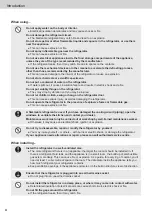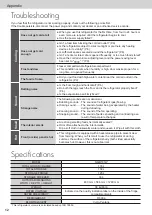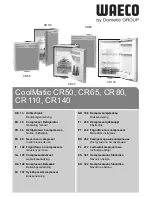
10
Appendix
Appendix
How to clean
Before cleaning, be absolutely sure to disconnect the power plug from the power outlet
You can wipe off dirt easily as long as the dirt dries out by cold air.
Especially, cooking oil causes cracks in plastic parts and citrus fruit juice causes discoloration of the plastic parts.
If you have difficulty in cleaning off the dirt, dilute neutral kitchen detergent with water and wipe off with a wet cloth
to finish up.
Sections where are likely to get dirt
Door packing
If adhesion soup, fruit juice
Zang materials, easy
damaged and cause air
leakage.
Back side of a refrigerator,
floor, outlet
They are likely to get dirt due
to convection of air.
(as a guide, about once a year)
Evaporating pan (P.7, P.11)
If it is soiled with dust, it is
becoming difficulty to evaporate
water.
Water may spill and odor
may occur.
(as a guide, about once a year)
If it gets dusty or food juice
accumulates, wipe off.
Food-juice receiving part
Interior (remove parts and rinse them)
● Door shelf/bottle rack
● Upper freezer case
● Freezer case
Tap the bottom of these
shelves upward and
remove (tightly attached)
Take the freezer upper
case out facing up the
front
1
Slide the door and lift
it more. Then, lay it on
the floor
2
Open the refrigerator
compartment door and
pull the case out
Clean up the refrigerator
upon become dirty!
Requests:
● Trays are made of glass.
Please handle it with care so that it will not drop
and cause damage or injuries.
● Do not use the following things.
(otherwise, the surface may get damage)
Polishing powder,
powder soap
Benzine,
thinner, alcohol
Very hot water or
boiling water
Scrub brush,
polishing sponge
alkaline or
mildly alkaline
Kitchen detergent
(plastic parts may get broken)
Kitchen dishcloth
(salt content contained in
soy sauce may rust the
surface of the door)










































